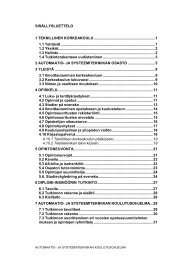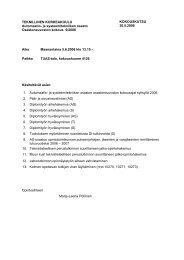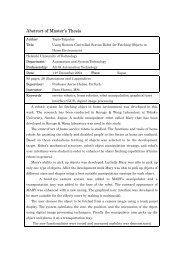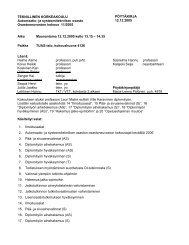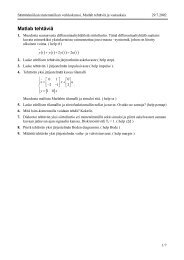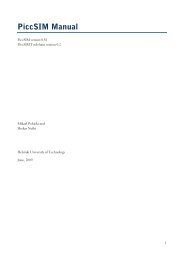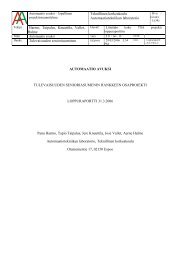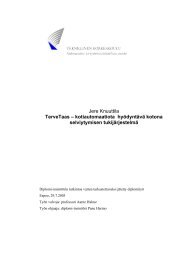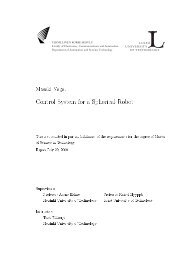fem modelling of a bellows and a bellows- based micromanipulator
fem modelling of a bellows and a bellows- based micromanipulator
fem modelling of a bellows and a bellows- based micromanipulator
You also want an ePaper? Increase the reach of your titles
YUMPU automatically turns print PDFs into web optimized ePapers that Google loves.
FEM <strong>modelling</strong> <strong>of</strong> a <strong>bellows</strong> <strong>and</strong> a <strong>bellows</strong>-<strong>based</strong> <strong>micromanipulator</strong>III. Modelling3.3.1 CONSTANT BENDING FORCEFor the same reasons as mentioned in the spring-rate simulation, a force cannot be applied atonce on the <strong>bellows</strong>, because it could initiate errors in the starting K matrix. Hence, the forcehas to be applied gradually, in several steps in the beginning, <strong>and</strong> only after that, the interiorvarying pressure load can be administered:Time-varying applied loadsLoads [%]1009080706050403020100ForcePressure1 2 3 4 5 6 7 8StepsSo, at step 3, the initial conditions <strong>and</strong> the correct parameters are reached, which canafterwards be used with beams-formulas. In the following steps, Q may increase because <strong>of</strong>the increasing stiffness, so that the obtained δx displacement should decrease. To get theexpected curve, care must be taken to interpret the simulation's result .Effectively, the δx a displacement, induced by the augmentation <strong>of</strong> the <strong>bellows</strong>' stiffness,decreases in a very small magnitude. But the axial growth δy <strong>of</strong> the <strong>bellows</strong> generated by theinternal pressure will be much more significant. Because <strong>of</strong> the angle α on top <strong>of</strong> the <strong>bellows</strong>,δx b displacement is also induced, in an increasing way, as shown by figure 21.Bellows' growthBending at p i ≠ 0Initial bending at p i = 0hδx 2δyαδx 1Bellows' growthFigure 21The effective decrease<strong>of</strong> δx 1 has to becalculated, taking intoaccount δx 2 , that isinduced by δy, whenapplying a constantforce F, <strong>and</strong> a varyinginterior pressure p.Bending at p i ≠ 0Initial bending at p i = 0The s<strong>of</strong>tware will not give us directly δy, but only the h displacement at the very top <strong>of</strong> the<strong>bellows</strong>, <strong>and</strong> the rotation α <strong>of</strong> the element located at that end-point. Hence, δx b can becalculated:δx b = h·tan(α) (3.9)Since the value <strong>of</strong> the initial bending δx at step 3 is known, the correct δx a decrease <strong>of</strong> the<strong>bellows</strong>' bending can easily be deduced, when adding an interior pressure p i ≠ 0.27



